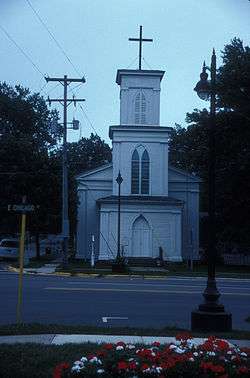Grace Episcopal Church (Jonesville, Michigan)
Grace Episcopal Church is a historic church at 360 East Chicago Street in Jonesville, Michigan. It was designated a Michigan State Historic Site [2] and listed on the National Register of Historic Places in 1971.[1] It is one of the first church buildings constructed in Michigan west of Detroit, and is one of the few surviving examples of indigenous church architecture in the state.[2]
Grace Episcopal Church | |
 Church in 2006 | |
  | |
| Location | 360 E. Chicago St., Jonesville, Michigan |
|---|---|
| Coordinates | 41°59′3″N 84°39′37″W |
| Area | less than one acre |
| Built | 1848 |
| Architectural style | Gothic, Greek Revival |
| NRHP reference No. | 71000391[1] |
| Significant dates | |
| Added to NRHP | May 6, 1971 |
| Designated MSHS | January 6, 1971[2] |
History
In 1833, the Episcopal missionary William N. Lyster left Ireland for the United States, and eventually became the restor of a mission in Tecumseh, Michigan.[3] From there, he traveled throughout southern Michigan to minister to isolated communities; in 1836 he held the first church service in Jonesville.[2] Two years later, a parish was organized by Darius Barker. In 1844, the congregation began constructing this church; it was completed on November 15, 1848, at a cost of $3,000.
In 1946, an old schoolhouse was moved to the site of the church to serve as a parish hall.[2] The church was deconsecrated and sold in 2007, and currently houses a coffee house.[4]
Description
Grace Episcopal Church is a 1-1/2 story rectangular Greek Revival frame structure covered in clapboard.[2] The building has a single-story projecting entry vestibule, atop which is a square tower which intersects with the main structure.[3] Square pilasters run up each corner of the building, and both the entry projection and the main structure are topped with a gable roof.
Gothic double-arched lancet windows line the sides of the building, providing the building with a somewhat rare mix of Greek Revival and Gothic styles.[5] Similar single-arched windows are on each side of the entry vestibule.
Black walnut paneling lined the interior, and the pews are constructed of the same wood.[2] A small altar, also of black walnut, is set amongst frescoes.[6]
References
- "National Register Information System". National Register of Historic Places. National Park Service. July 9, 2010.
- "Grace Episcopal Church". Michigan State Housing Development Authority: Historic Sites Online. Archived from the original on December 2, 2013. Retrieved November 13, 2013.
- Jim Schutze (November 13, 1970), NATIONAL REGISTER OF HISTORIC PLACES INVENTORY- NOMINATION FORM: Grace Episcopal Church
- Nancy Hastings. "Coffee house is 'grounded in grace'". Hillsdale.net. Retrieved November 26, 2013.
- Kathryn Bishop Eckert (1993), Buildings of Michigan, Oxford University Press, p. 20, ISBN 9780195061499
- Writers' Program, Michigan (1973), Michigan, a Guide to the Wolverine State, North American Book Dist LLC, p. 394, ISBN 9780403021727
Further reading
- Grace Episcopal Church (Jonesville, Mich.), Historic Grace Episcopal Church

